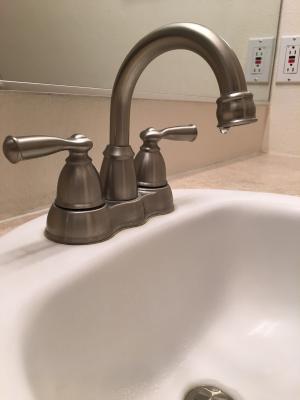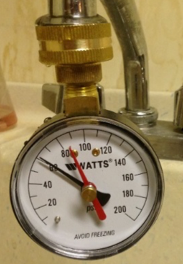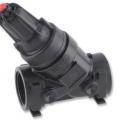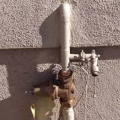Scope
Upon installation of the plumbing system, verify that the static service pressure is a maximum of 60 pounds per square inch (psi) (414 kilopascal [kPa]).
Reduced water pressure saves water, conserves energy, and helps ensure proper operation of fixtures and appliances.
For units in multi-family buildings, the service pressure within each unit shall be at a maximum of 60 psi.
Compliance for homes supplied by groundwater wells shall be achieved by use of a pressure tank.
Compliance for single-family homes with publicly supplied water shall be achieved by one of the following methods:
- Use of a pressure-regulating valve (PRV) downstream of the point of connection. All fixture connections shall be downstream of the PRV; OR
- Determination that the service pressure at the home is 60 psi or less at the time of inspection and documentation from the public water supplier that the service pressure is unlikely to regularly exceed 60 psi at the home on a daily or seasonal basis.
*Piping for fire sprinkler systems is excluded from this requirement and should comply with state and local codes and regulations.
See the Compliance Tab for links to related codes and standards and voluntary federal energy-efficiency program requirements.
Description
Static service pressure refers to the pipeline or municipal water supply pressure when water is not flowing.

Municipalities and private water supply companies use pumps and pumping stations to boost water supply pressures in supply mains. In some cases, the pressure can exceed 200 psi. Most plumbing codes require Pressure Reducing Valves on domestic systems where the pressure of the supplied water exceeds 80 psi, as higher pressures can rupture pipes and damage fixtures.
Ensuring that the pressure entering a home does not exceed 60 psi can result in significant water savings by reducing the amount of water coming out of the fixture and reducing the likelihood of leaking water pipes, leaking water heaters, dripping faucets, and catastrophic events if pipes, hoses, or component parts in a water-using product burst. Keeping the pressure at 60 psi can also help in maintaining the performance of water fixtures, reduce dishwasher and washing machine noise, and reduce breakdowns in a plumbing system.
Appropriate water pressure will reduce hot water flows and consumption, which will also reduce the amount of energy required to heat the water, resulting in energy and dollar savings for homeowners.
The most common type of water pressure-reducing valve is a direct-acting valve. Direct-acting valves consist of globe-type bodies with a spring-loaded, heat-resistant diaphragm connected to the outlet of the valve. Water entering the valve is constricted within the valve body and directed through the inner chamber, which is controlled by an adjustable spring-loaded diaphragm and disc. Even if the water pressure fluctuates, the PRV ensures a constant flow of water at a functional pressure. In general, the minimum flow through a PRV should be between 10 and 15 percent of the maximum desired flow rate. Select a regulator for which operating pressures fall within the middle of its rated range, not based on the size of the pipe to which it will be attached.
It is important to note that use of a PRV creates a closed system and that thermal expansion can lead to increased pressure in some cases. Local plumbing codes should provide guidance on controlling this issue.
Builders should also note that piping for home fire sprinkler systems is not included in this specification. These systems should be installed and maintained in accordance with state and local codes and regulations.
Success
The inspector will determine if the home receives publicly supplied water or receives water from a groundwater well. If the home’s water is supplied by a groundwater well, the inspector will verify that a pressure tank is installed and that the pressure is set to 60 psi or less. If the home’s water is publicly supplied, the inspector will either verify that a PRV is installed downstream of the point of connection or verify that the water pressure to the home or unit in a multi-family building is 60 psi or less. If a PRV is not installed, the inspector will also verify that there is written documentation from the water supplier that pressure is not expected to exceed 60 psi.
Climate
No climate specific information applies.
Training
Compliance
Retrofit
SCOPE
Reduced water pressure saves water, conserves energy, and helps ensure proper operation of fixtures and appliances in both new and existing homes. Guidance for the measures described in this guide are applicable to both new and existing homes.
DOE’s Standard Work Specifications describe practices to complete whole-house energy upgrades safely without injury or hazardous exposure in the section on Global Worker Safety.
More
More Info.
Access to some references may require purchase from the publisher. While we continually update our database, links may have changed since posting. Please contact our webmaster if you find broken links.
The following authors and organizations contributed to the content in this Guide.




